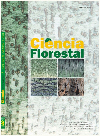
|
Ciência Florestal
Centro de Pesquisas Florestais - CEPEF, Departamento de Ciências Florestais - DCFL, Programa de Pós Graduação em Engenharia Florestal - PPGEF
ISSN: 0103-9954
EISSN: 0103-9954
Vol. 24, No. 4, 2015, pp. 987-994
|
 Bioline Code: cf14093
Bioline Code: cf14093
Full paper language: English
Document type: Research Article
Document available free of charge
|
|
|
Ciência Florestal, Vol. 24, No. 4, 2015, pp. 987-994
| en |
EVALUATION OF STRENGTH TO SHEAR AND DELAMINATION IN GLUED LAMINATED WOOD
Neto, Carlito Calil; Christoforo, André Luis; Filho, Sérgio Luiz Moni Ribeiro; Lahr, Francisco Antonio Rocco & Junior, Carlito Calil
Abstract
The Glued Laminated Wood has a large range of applications. In Brazil, its employment as cross-piece
poles for overhead electrical power has attracted the attention of companies in the industry, motivated
by the potential use of this material. Among the factors that influence the mechanical performance of
Glulam solutions stand out efficiency and affinity of the adhesives to the species of wood used, the type of
treatment and moisture content of wood veneer, motivating the development of new research on this topic.
This research aimed to investigate, by Design of Experiments (DOE), the influence of wood (pinus, teca, eucalipto), adhesive (Purbond; Cascophen) and treatment (CCA, CCB, CCBS ) in the variable responses
shear strength and delamination, consisting in the same combination factors evaluated in ANEEL/EESCPD220-
07 project: Head Crosshead Glulam Series. The results of the statistical analysis showed that the
species factor expressed significant effect for both response variables evaluated, did not occur with adhesive
and treatment factors. Moisture content was significant in the wood evaluated when analyzed the shear
strength, and the teca wood showed the highest shear strength and also relating to the delamination.
Keywords
glued laminated wood; design of experiments (DOE); crosshead; delamination
|
| |
| pt |
AVALIAÇÃO DA RESISTÊNCIA AO CISALHAMENTO E À DELAMINAÇÃO EM MADEIRA LAMINADA COLADA
Neto, Carlito Calil; Christoforo, André Luis; Filho, Sérgio Luiz Moni Ribeiro; Lahr, Francisco Antonio Rocco & Junior, Carlito Calil
Resumo
A Madeira Laminada Colada (MLC) apresenta uma grande gama de aplicações. No Brasil, o seu emprego na
forma de cruzetas para postes de rede aérea de distribuição de energia elétrica tem despertado a atenção de
companhias do ramo, motivadas pelo potencial de emprego deste material. Dentre os fatores que influenciam
o desempenho mecânico de soluções em MLC destacam-se a eficiência e a afinidade dos adesivos para
com as espécies de madeiras utilizadas, o tipo de tratamento e o teor de umidade das lâminas de madeira,
motivando o desenvolvimento de novas pesquisas nesta temática. Este trabalho objetivou investigar, via
Método de Planejamento Fatorial de Experimentos (DOE), a influência dos fatores tipo de madeira (pinus;
teca; eucalipto), adesivo (Purbond; Cascophen) e tratamento (CCA; CCB; CCBS) nas variáveis respostas
resistência ao cisalhamento e à delaminação, consistindo nos mesmos fatores e combinação avaliados no
projeto de Pesquisa e Desenvolvimento da ANEEL/EESC-PD220-07: Cabeça de Série da Cruzeta de MLC.
Os resultados da análise estatística revelaram que o fator tipo de madeira expressou efeito significativo
para ambas as variáveis respostas avaliadas, o mesmo não ocorrendo com os fatores tipo de adesivo e
de tratamento. Já o teor de umidade mostrou ser significativo em todas as espécies de madeira quando
analisada a resistência ao cisalhamento, apresentando a madeira de teca a maior resistência ao cisalhamento
e à delaminação.
Palavras-chave
madeira laminada colada (MLC); planejamento fatorial de experimentos (DOE); cruzetas; delaminação
|
| |
© Copyright 2014 - Ciência Florestal
Alternative site location: http://cascavel.ufsm.br/revistas/ojs-2.2.2/index.php/cienciaflorestal/index
|
|
